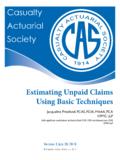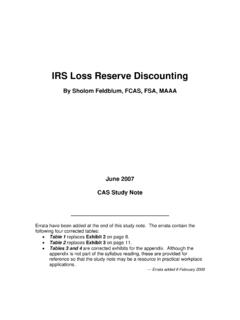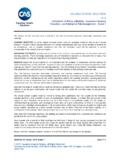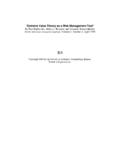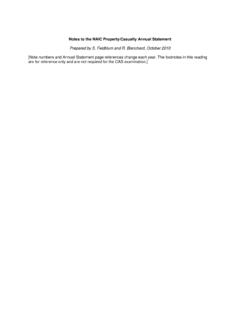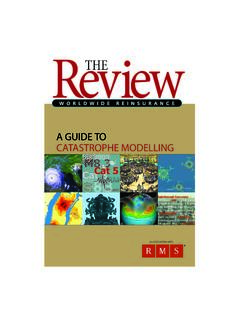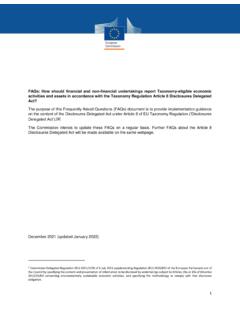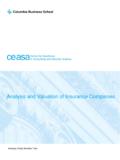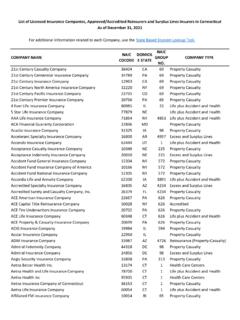Transcription of Basic Reinsurance Accounting—Selected Topics
1 Basic Reinsurance Accounting Selected Topics By Ralph S. Blanchard, III, FCAS, MAAA and Jim Klann, FCAS, MAAA October 2012 CAS Study Note Basic Reinsurance Accounting Selected Topics October 2012 The purpose of this study note is to educate actuaries on certain Basic Reinsurance accounting Topics that may be omitted in other syllabus readings. Specifically, this study note provides examples of how ceded Reinsurance impacts an insurer s financial statements and key financial metrics. Ceded Reinsurance Impact on financial Statements The book Reinsurance Principles and Practices by Connor Harrison lists the following six principal functions of Reinsurance .
2 1. Increase large line capacity 2. Provide catastrophe protection 3. Stabilize loss experience 4. Provide surplus relief 5. Facilitate withdrawal from a market segment 6. Provide underwriting guidance This paper will give an example of each of these types of Reinsurance , and examine the impact to the ceding company on the following: Surplus Loss reserves Unearned Premiums Leverage ratios Income statement The financial statements shown in the examples follow the SAP convention of offsetting ceded liabilities against gross liabilities. 1. Increase large line capacity This example deals with the situation where a company is only willing to expose itself to a certain amount of loss per policy, but portions of its potential market demand greater coverage.
3 Beginning Assumptions (the Without column): XYZ insurance company writes homeowners insurance. It is unable or unwilling to write policies for homes with insured values over $500,000 without a suitable Reinsurance program. XYZ writes $1 million of annual premium for this market, in a steady state with a level premium volume. The loss ratio is 75%. The only expense is commissions, which equal 20% of premium. Loss reserves = $750,000 and surplus = $ million. Since XYZ is in a steady state, reserves and surplus are constant throughout the year. XYZ holds cash equal to 10% of gross loss reserves, agent balances equal to 10% of premium, and the remainder of its assets in bonds.
4 The bonds and cash earn investment income at a rate of 5%. There are no income taxes. Altered Assumptions (the With column): XYZ buys a surplus share pro rata Reinsurance treaty that cedes premiums and losses for higher valued homes, with the ceding percentage for each policy equal to the excess of the home value over $500,000 divided by the total home value. (For example, for a home worth $625,000, the ceded percentage would be 125/625, or 20%.) This is the only Reinsurance purchased by XYZ. The altered assumptions again reflect level premium volume and a steady state, in which XYZ has been writing identical business over a period of years.
5 Page 1 of 13 Basic Reinsurance Accounting Selected Topics October 2012 With access to the higher-value market, XYZ writes 40% more business and achieves $ million in gross written premium. However under the treaties it cedes $300,000 of premium. The loss ratio remains 75% on both net and ceded business. However reserves increase relative to loss, because claims on more expensive properties take longer to develop. The expense ratio remains 20% of net written premium. The reinsurer pays a ceding commission to compensate for commissions on ceded business, so there is no net additional commission on ceded premium.
6 Agent balances remain equal to 10% of premium, of which a portion, equal to the percent of premium ceded, is due to the reinsurer. We arbitrarily assume only a small increase in surplus, matching the increase in current year income. Page 2 of 13 Basic Reinsurance Accounting Selected Topics October 2012 Example 1 XYZ Insurance CompanyImpact of Large Line Capacity TreatyBalance SheetW ithoutW ithDifferenceAssetsBonds2,575 2,662 87 Cash75 113 38 Agents Balances100 140 40 Total2,750 2,915 165 LiabilitiesLoss ReservesGross750 1,125 375 Ceded0300300 Net750 825 75 Unearned PremiumsGross500 700 200 Ceded0150150 Net500 550 50 Ceded Agents Balances03030 Total1.
7 250 1,405 155 Surplus1,500 1,510 10 Income StatementEarned PremiumGross1,000 1,400 400 Ceded0300300 Net1,000 1,100 100 Incurred LossesGross750 1,050 300 Ceded0225225 Net750 825 75 Expenses200 220 20 Underwriting Income50 55 5 Investment Income133 139 6 Total Income183 194 11 Written PremiumsGross1,000 1,400 400 Ceded0300300 Net1,000 1,100 100 Other financial StatisticsGross W P/Surplus67%93%26%Net W P/Surplus67%73%6%Gross Loss Reserves/Surplus50%75%25%Net Loss Reserves/Surplus50%55%5%Ceded Reserves/Surplus0%30%30% Page 3 of 13 Basic Reinsurance Accounting Selected Topics October 2012 Analysis of impact (from Exhibit 1) Surplus We assumed no impact on surplus other than earnings on additional business opportunities.
8 In reality, given the additional premium and reserves and Reinsurance collectability risk, the ceding company may desire (or be forced to) hold more surplus to support these greater risks. Alternatively, it could decide to reduce volume to retain the same level of surplus relative to risk. Loss reserves Both gross and net loss reserves increase, partly due to increased premium volume and partly due to the nature of new business being pursued, with slower development on larger claims. Unearned Premiums increase, but remain the same in proportion to premium Leverage ratios Net leverage ratios increase slightly because of the change in business model.
9 Gross leverage ratios begin to differ materially from the net leverage ratios, and Reinsurance leverage becomes important due to the purchase of Reinsurance . Income statement Little changed on a net basis, but over time the riskier book and changing cost of Reinsurance may introduce greater volatility. 2. Provide Catastrophe Protection This example deals with the situation where the company desires to reduce its potential loss from a catastrophic event. Beginning Assumptions (the Without columns): ABC insurance company is in the same situation as XYZ insurance company in Exhibit 1, prior to the purchase of Reinsurance .
10 Hence, the without column in Exhibit 1 also applies to Exhibit 2, unless a catastrophe event occurs. If a cat event occurs, ABC incurs an additional $500,000 in loss, of which $50,000 is paid by the end of the year and the remainder is reserved. Altered Assumptions (the With columns): ABC buys a catastrophe treaty on January 1st, for 5% of gross premium, that pays for losses from a single event in excess of 10% of premium. This premium is payable at the start of the year. (Note that this assumption leaves zero ceded unearned at December 31st. Ceded unearned would be greater than zero if the ceded Reinsurance policy term had not yet expired.)



